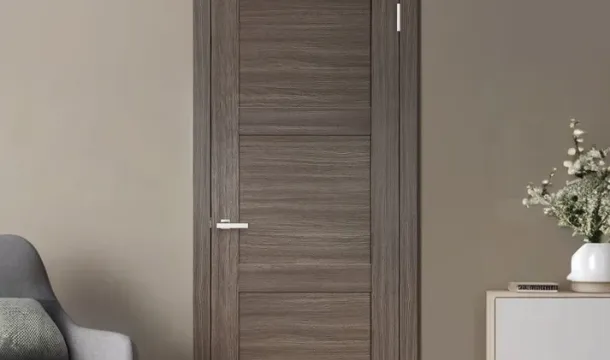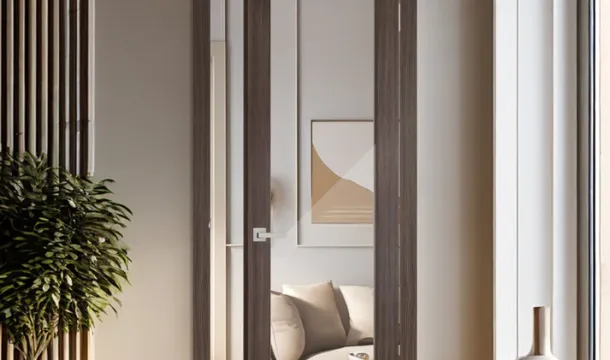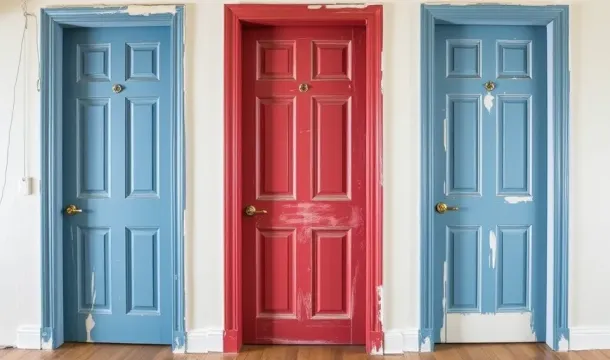Why bathroom door ventilation matters for your home
Popular Articles
Install a door with a ventilation grille or a gap of at least one inch at the bottom. This simple step prevents moisture from being trapped inside the bathroom, a primary cause of mould growth and structural damage. In Canadian climates, where indoor heating runs for much of the year, the temperature difference between a steamy bathroom and a cooler hallway creates a pressure differential. A properly vented door allows this moist air to escape, actively pulling it out through your bathroom's exhaust fan. Without this airflow, condensation settles on walls, ceilings, and inside walls, leading to costly repairs.
Beyond moisture control, adequate ventilation directly impacts air quality and door longevity. Bathrooms accumulate humidity levels that can exceed 60% during a shower. This environment warps wooden door frames and causes paint to peel. A solid core door, while excellent for privacy, will act as a barrier without a ventilation path. For homes in humid Montreal summers or damp Vancouver winters, specifying a door with a built-in louvre panel or a bottom sweep that allows for airflow is a practical solution. This protects your investment in European-style doors, ensuring their elegant finishes and structural integrity last for years.
Selecting the right door combines this functional need with aesthetic goals. For a budget-friendly and moisture-resistant option, consider doors with a solid wood frame and a honeycomb paper core, finished with a durable PVC or laminate layer. These models resist warping and are easy to clean. For superior sound insulation and a more substantial feel, a solid core door with a integrated louvre offers a premium alternative. We ensure all our doors, delivered across Toronto, Ottawa, and Calgary, are suited to local conditions, providing clear installation guides for a snug fit that maintains necessary airflow for a healthier, more comfortable home.
Preventing Mold and Mildew
Wipe down wet surfaces after every shower. Use a squeegee on tiles and glass doors to remove standing water, the primary source of moisture for mold growth. This simple 30-second habit drastically reduces the ambient humidity that spores need to thrive.
Maintain bathroom humidity levels below 50% to inhibit mold development. Use a hygrometer to monitor conditions; if levels consistently exceed 60%, install a ventilation fan with a minimum capacity of 50 CFM for standard bathrooms. For larger spaces, calculate required CFM by multiplying the room's square footage by 1.1.
Seal all grout lines annually with a penetrating silicone-based sealer. This creates a waterproof barrier within the porous cement, preventing moisture from seeping into walls. Pay close attention to corners and the shower floor-to-wall junction, common failure points for mold infiltration.
Inspect and clean ventilation ducts every two years. Accumulated dust and debris restrict airflow, rendering your exhaust system ineffective. A clogged duct can reduce airflow by up to 60%, creating the stagnant, humid environment where mildew colonies establish.
Choose moisture-resistant materials for any bathroom updates. Solid core doors with PVC or full acrylic finishes resist warping and moisture penetration far better than hollow core alternatives. These materials provide a non-porous surface that mold cannot easily colonize.
Controlling Humidity Levels
Maintain a relative humidity level between 30% and 50% in your home. You can track this with a digital hygrometer, a device costing between $15 and $40. Levels consistently above 60% create ideal conditions for dust mites and can cause condensation on windows, signaling excessive moisture.
Extraction Fan Operation and Verification
Run your bathroom exhaust fan for at least 20 minutes after a shower. Do not turn it off immediately. To check its performance, hold a single square of toilet paper against the vent grill. A properly functioning fan will hold the paper in place. If it falls, the fan likely lacks sufficient power or the duct is obstructed. Consider upgrading to a fan rated for your bathroom's cubic footage, with a minimum of 50 CFM for standard sizes and 80+ CFM for larger master bathrooms.
Strategic Airflow and Moisture Absorption
Keep the bathroom door open after bathing once the majority of steam has dissipated. This practice allows humid air to circulate and mix with drier household air, preventing it from being trapped. For an immediate effect, place a squeegee in the shower and make a habit of wiping down walls and glass doors. This simple action removes a significant volume of water before it can evaporate into the air. In climates with harsh winters, a small, portable dehumidifier can assist in managing overall ambient moisture without over-drying the air.
Eliminating Lingering Odors
Install a small, downward-facing exhaust fan directly above the toilet bowl. This placement captures odors at the source before they disperse, increasing removal speed by up to 60% compared to a standard ceiling-mounted unit. Choose a fan with a minimum 80 CFM (cubic feet per minute) rating and a continuous low-speed operation setting for constant air exchange.
Upgrade to a carbon-impregnated activated charcoal filter for your ventilation system. These filters adsorb odor-causing sulfur compounds and organic gases that standard particulate filters miss. Replace these specialized filters every 6-9 months, or more frequently in high-use households, to maintain their odor-neutralizing properties.
Apply a photocatalytic coating to interior bathroom surfaces, including tiles and the back of the door. When exposed to light, this titanium dioxide-based treatment breaks down odor molecules and volatile organic compounds (VOCs) at a molecular level. The coating remains active for up to two years, providing a passive, continuous deodorizing effect without chemicals or perfumes.
Popular Articles

Choosing the Perfect Interior Doors for Your Canadian Home

A Complete Guide to Choosing Interior Doors for Canadian Homes
